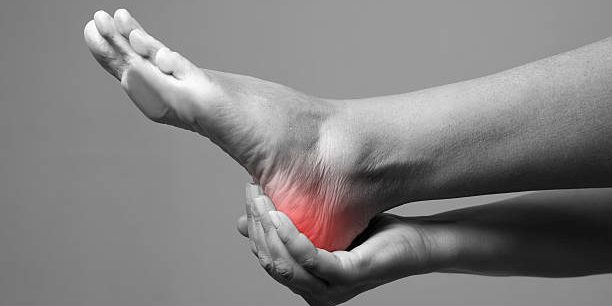If you’ve ever had plantar fasciitis or known someone with plantar fasciitis, you’ll know it’s a painful experience you’d seek to avoid through preventative measures. While its a common cause of heel pain, there are some effective self-care measures that may help provide quick relief from plantar fasciitis such as applying ice to the affected area to reduce inflammation and pain, over-the counter medication, wear shoes with good arch support, and performing stretching exercises for the plantar fascia and calf muscles, which we’ll cover below.
Anyone can develop plantar fasciitis, but it is more common in certain groups of people. Risk factors for developing plantar fasciitis include age (more common in middle-aged people), occupation, weight, foot structure and physical activity as engaging in activities that put a lot of strain on the feet, such as running, yoga or dancing, can increase the risk of plantar fasciitis.
It’s important to note that these measures can provide temporary relief, but they are not a substitute for a comprehensive treatment plan that you should consult with a healthcare provider for a proper diagnosis and treatment plan, and consider at-home tools and exercises you can use to both relieve plantar fasciitis, but also prevent plantar fasciitis in the future.
What is plantar fasciitis?
Plantar fasciitis is a common cause of heel pain. It is characterized by pain and inflammation of the plantar fascia, a thick band of tissue that runs across the bottom of your foot and connects your heel bone to your toes.
The plantar fascia helps to support the arch of your foot and absorb shock as you walk or run. When the plantar fascia becomes damaged or strained, it can cause pain and inflammation in the heel and arch of the foot. Plantar fasciitis is often caused by overuse or improper footwear, and it is more common in people who are overweight, have high arches or flat feet, or who stand or walk on hard surfaces for long periods of time.
How can I get quick relief from plantar fasciitis?
Here are a few strategies you can try to get immediate relief from plantar fasciitis:
- Ice your heel: Place an ice pack or bag of frozen vegetables wrapped in a thin towel on your heel for about 15 minutes to help reduce inflammation.
- Stretch your foot: Try some simple stretches to help alleviate pain and improve flexibility in your foot. One effective stretch involves using a towel to gently pull your toes towards your body while seated. A slant board or calf stretcher is also an effective tool to help relieve plantar fasciitis pain. Consult your medical advisor or physio therapist to understand how a slant board can be properly used to reduce future plantar fasciitis.
- Take over-the-counter pain medication: Non-steroidal anti-inflammatory drugs (NSAIDs) like ibuprofen and naproxen can help reduce inflammation and pain. Consult a medical advisor first before considering.
- Wear comfortable, supportive shoes: Make sure you’re wearing shoes that provide good arch support and cushioning to help alleviate pressure on your heel.
- Try a heel cup or shoe insert: These devices can help reduce strain on your plantar fascia by elevating your heel and absorbing shock.
- Avoid walking barefoot: Going barefoot can put extra strain on your plantar fascia, so try to avoid walking barefoot on hard surfaces.
It’s important to note that these strategies can provide temporary relief, but they may not address the underlying cause of your plantar fasciitis. If you’re experiencing persistent or severe heel pain, you should see a healthcare provider for a proper diagnosis and treatment plan.
How a slant board helps relieve plantar fasciitis
Slant boards like BAM Athletica’s wooden slant board can be used to stretch the plantar fascia and calf muscles in order to help alleviate plantar fasciitis pain. To use a slant board to help relieve plantar fascia:
- Stand on the slant board with your toes on the highest part of the board and your heels hanging off the edge.
- Slowly shift your weight onto your heels, allowing them to stretch downward towards the ground.
- Hold this position for 30 seconds to 1 minute, then relax and repeat.
It’s important to start slowly and gradually increase the duration of the stretch as your muscles become more flexible. It’s also a good idea to stretch both sides of the body evenly to avoid imbalances.
Keep in mind that stretching is just one part of a comprehensive treatment plan for plantar fasciitis. It’s important to also address any underlying causes of the condition, such as improper footwear or overuse, and to consult with a healthcare provider for a proper diagnosis and treatment plan.
Can a physio therapist help with plantar fasciitis?
A physiotherapist can help with plantar fasciitis by providing a variety of treatments and exercises to reduce pain and improve flexibility and strength in the foot and ankle. These may include:
- Stretching and strengthening exercises: A physiotherapist can teach you specific stretches and exercises to help improve the flexibility and strength of the muscles and tendons in your foot and ankle, which can help alleviate pain and reduce the risk of further injury.
- Massage and other manual therapies: Massage and other manual therapies, such as myofascial release and trigger point therapy, can help reduce inflammation and tension in the plantar fascia and other muscles in the foot and ankle.
- Orthotic devices: A physiotherapist may recommend the use of orthotic devices, such as shoe inserts or custom orthotics, to help correct any underlying foot abnormalities and improve the function of your foot and ankle.
- Gait analysis and retraining: A physiotherapist can assess your walking and running pattern (gait) and provide exercises and training to help improve your technique and reduce the strain on your plantar fascia.
A physiotherapist can also provide education on proper footwear and how to manage your activities to reduce the risk of further injury. They may also recommend other treatments, such as taping or bracing, to help support the foot and reduce pain.








